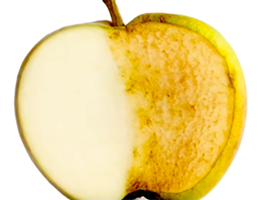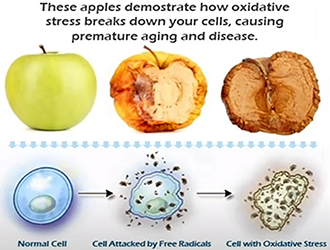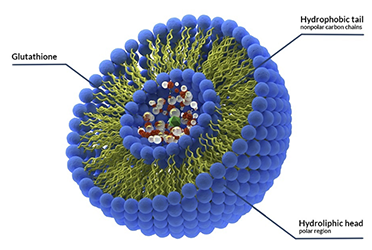Antioxidants - Free Oxygen Radicals - Oxidative Stress - ORAC Values - Aging and more...
The benefits of antioxidants are vital! So what are antioxidants, how do they work, where are they found and how to use them in the most beneficial way?
The word antioxidant consists of two parts, anti means against and oxidant means oxidizing, corroding. Antioxidant as a whole means against rusting. Just as iron reacts with oxygen and rusts due to weather conditions, nearly 14 trillion cells in the body are also oxidized by the effect of substances called free oxygen radicals, which are a by-product of the metabolism, and this is called Oxidative Stress.
Detailed reading:
Oxidative stress, aging and diseases
For example, if you cut an apple into two and leave it open, after a while, the white flesh of the apple will react with oxygen and turn yellow and gradually darken. This is an oxidation event that occurs due to the reaction of apple tissue with oxygen.
However, if lemon juice containing plenty of antioxidant vitamin C is applied to the surface of the cut apple, this yellowing and blackening will be delayed. Vitamin C prevents oxidation with its antioxidant effect.
Just like the rusting of iron, like the oxidation and darkening of an apple, free oxygen radicals, which are the by-products of the
metabolism, begin to wear out and oxidize our cells.
Detailed reading:
Evolution of the Knowledge of Free Radicals and Other Oxidants
Let's take a closer look at free oxygen radicals. Free oxygen radicals occur as a byproduct of the metabolism. These molecules are highly unstable molecules lacking an electron, the most important examples being the superoxide molecule, peroxide molecule, hydroxyl ion molecule and hydroxyl radical molecule.
Detailed reading:
Free radicals and antioxidants in health and disease
These negatively charged molecules react with the surrounding tissues in order to reach equilibrium and steal an electron from these tissues. In this process, damage occurs in the tissues they react with, and more importantly, in DNA. This activity, called oxidative stress, is one of the most important risk factors for cancers, especially cardiovascular diseases and damaging all tissues.
Apart from these free oxygen radicals, which emerge as a by-product of our energy metabolism, there are also some free oxygen radicals that we take from the outside or are formed by external factors. These are cigarette smoke, air pollution, alcohol, high blood sugar, dietary toxins, oils (polyunsaturated fatty acids),
inflammation, ultraviolet rays from the sun, infections, and excessively strenuous exercise.
It is necessary to establish a balance between these oxidant substances, which are either taken from the outside or as a by-product of metabolism, and antioxidants. Essentially, there is a natural antioxidant system inside the cells, this is called Antioxidant Response Element.
The antioxidant response element system causes the production of some natural antioxidant substances in order to combat free oxygen radicals and oxidant substances formed in the cells. Chief among these is a very important antioxidant called Glutathione. This is a very important antioxidant substance produced by the body itself.
Detailed reading:
Glutathione: Overview of its protective roles, measurement and biosynthesis
Antioxidants are the antidote to oxidants that damage our cells. The free oxygen radicals we take from both inside and outside often exceed the capacity of our natural antioxidant system, and in this case, the antioxidants we take from outside with food become very important.
Antioxidants act with negatively charged free oxygen radical molecules, binding them and preventing them from damaging cells. The most well-known antioxidants are vitamins C and E, and plant molecules of the Flavonoid type that we get from fruits and vegetables.
A
diet rich in antioxidants is the most important insurance of our health. The most important source of antioxidants is plant foods, namely fruits, vegetables, salads and legumes and spices.
However, the antioxidant capacity of each food is different and this capacity is measured by the ORAC (Oxygen Radical Absorbance Capacity) value.
Foods with the highest ORAC value, that is, antioxidant capacity are (These values are taken from the records of the American Agricultural Food Organization USDA food data laboratory. The USDA daily antioxidant intake recommendation is 3.000 to 5.000 units per day. The values given below are the measurements in 100 gr of food):
Clove: 314.466
Sumac: 312.400
Cinnamon: 267.536
Turmeric: 102.700
Cacao: 80.933
Black Pepper: 27.618
Red Pepper: 23.636
Flaxseed: 19.600
Coffee: 14.500
Mint: 13.970
Thyme: 13.978
Wallnut: 13.541
Artichoke: 8.459
Kidney Bean: 8.320
Lentil: 7.282
Blueberry: 6.552
Blackberry: 5.347
Garlic: 5.141
Apple: 4.000
Red Wine: 3.873
Cherry - Sour Cherry: 3.277
Broccoli: 3.082
Red Cabbage: 3.083
Pomegranate: 2.200
Arugula: 1.904
Green Tea: 1.864
Orange: 1.819
Tomato: 415
Lettuce: 396
As additional information, the brighter and darker the color of a food, the higher its antioxidant value, and the red and purple-colored plants are rich in antioxidants. Modest foods that are rarely consumed: spices, legumes, walnuts and coffee are champions in terms of antioxidants.
It is recommended to take a minimum of 3,000 - 5,000 units of
antioxidants per day, but there is no harm in excess, for example, it would be much better if this amount is increased to 10,000 - 15,000 units.
It should not be forgotten that the need for antioxidants increases with age and antioxidants have the ability to protect from many chronic diseases, cardiovascular diseases,
hypertension and even many types of cancer. Apart from the positive effects of antioxidants on general health, they also have very important benefits
for skin health.
Although the ORAC values of many foods taken on a daily basis seem low, these values are the values in 100 grams of that food, for example, when an orange with an average of 300 grams is eaten, this value should be multiplied by 3 and it is seen that this meets the daily need for antioxidants, and also the vitamin and mineral values in these foods must not be forgotten. A diet rich in fruits, vegetables and salads and supported by spices is vital for a healthy life.
Oxidative stress, which destroys DNA and all other tissues, is one of the most important risk factor for Cancers, Cardiovascular Diseases and
Aging.
Increase your Antioxidants level with Sunrise which contains 22 superfoods and 10 Essential Vitamins like: Wild Alaskan Blueberry, Riboflavin, Niacin, Thiamin, Biotin, Pomegranate, Blueberry, Grape, Ginseng, Folate, Vitamin B5, Vitamin B6, Vitamin B12, Vitamin C..., and boost your Nitric Oxide and Omega 3 levels with
Wellness Triangle which will prevent cell deformation, protect heart and cardiovascular health, improve immune response, and prolong your life span. After only 30 days of regular use, you will easily notice the changes on your body, but better is to get a blood test at the beginning and at the end of the cure to see all the regenerations on the results. Take action today, improve your health, enhance your life quality... tomorrow may be too late!
Wellness Triangle is the best supplement, a complete support, unique in the world, that provides a healthy living with the regular use of only 3 products.
Learn More
Back to Home











